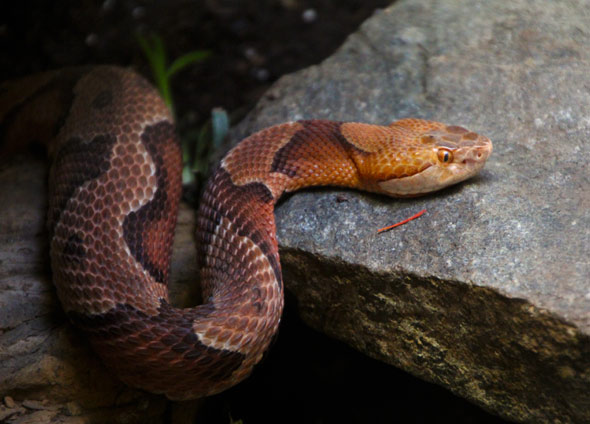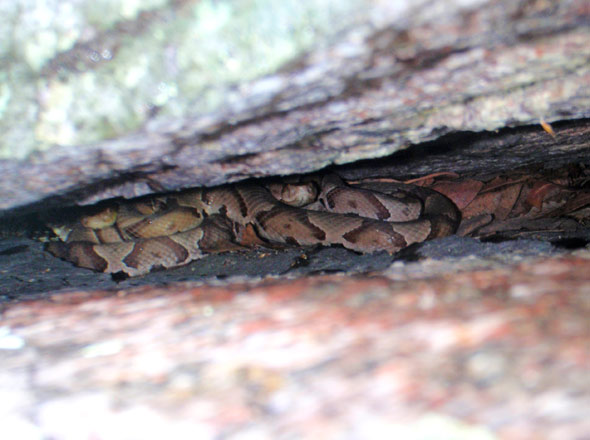Ask anyone you know and most will tell you a tale about the time they narrowly escaped a run-in with a copperhead. But the truth is more likely that the snake they encountered wasn’t a copperhead at all, and that it was much more interested in hiding or fleeing than engaging in a fight.
The copperhead’s status as the only venomous snake found in the Harford County/central Maryland area unfairly casts it in the role of the lone villain slithering through the local landscape – and their “sinister-looking” elliptical pupils, triangular head, and curved fangs don’t help their image much either. But, statistically- and medically-speaking, people are more of a threat to a copperhead than the copperhead is to them.
Rarely exceeding 3 ft in length, the copperhead is a stout snake that gets its name from its coppery-brown head. An ambush predator, the copperhead feeds primarily on mice, other small rodents, and frogs by waiting for their meal to come to them, rather than going out to stalk it.
Copperheads are widely known to den in rocky outcroppings, which is why one of the most notorious local havens for the snake is the King and Queen Seat at Rocks State Park. The Maryland Department of Natural Resources even warns on its website of “Copperheads found in rocks.” Rock climbers and hikers occasionally come across the snakes in the cracks and crevices of the stony cliffs, but know that if they leave the snakes alone, the snakes will return the favor.
Only in rare instances do humans and copperheads meet fang-to-flesh, but even when they do, the result is rarely serious and usually is more dangerous to the snake than the human. This July, a camper in the Rocks area was bitten by a copperhead and hospitalized for treatment. The Maryland Poison Control Center states that “2-6 people receive venomous snake bites in Maryland annually and that people rarely die from snake bites, even without medical treatment.”
The best snakebite treatment is to avoid getting bitten in the first place and DNR recommends Marylanders first learn to identify copperheads, so they can avoid encountering them. Far too many milksnakes, Northern water snakes, juvenile rat snakes, and other local serpents pay the ultimate price for bearing even the slightest resemblance to a copperhead. In Maryland, it is against the law to kill a copperhead, or any other native wildlife, without proper permitting.
DNR also recommends that hikers and campers watch where they place their hands, feet, and sleeping bag when hiking and camping; wear long pants and heavy boots when in copperhead territory; avoid rock piles and other habitats the snakes frequent; and never handle wild snakes – live or dead.
If bitten by a copperhead or any other venomous snake, the American Red Cross recommends washing the bite with soap and water; immobilizing the bitten area and keeping it lower than the heart; and seeking immediately medical help. No ice, tourniquets or incisions should be implemented whatsoever.
The copperhead is a unique character serving a niche role in our local ecosystem; it deserves the same rights and respect we grant the other inhabitants of our forests and fields.



